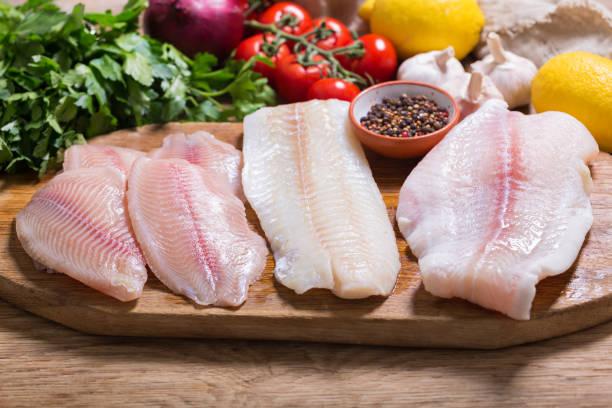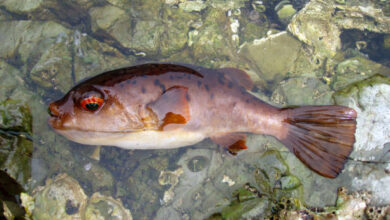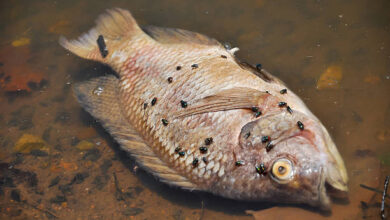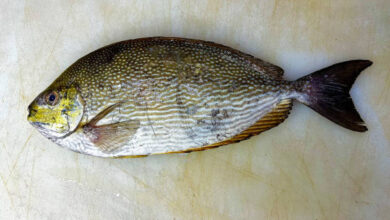What is pangasius fish and benefits

The Pangasius fish, often sold under the names of “basa” or “swai” in the United States, is a versatile and healthy protein option that has grown in popularity worldwide. This fish, known for its affordability and mild taste, offers various benefits to the environment, economy, and our health. Let’s delve into understanding what exactly Pangasius fish is and explore its many benefits.
Understanding the Pangasius Fish
Pangasius is a unique variety of catfish that calls the vibrant waters of Southeast Asia home, with the Mekong River in Vietnam being its main habitat. With its distinctive silver-grey hue and its sleek, glossy body, this fish is easily recognizable. It sports a solitary dorsal fin that stretches along its back, while its broad mouth filled with sharp teeth further sets it apart.
Two species of Pangasius, namely Pangasius bocourti and Pangasius hypophthalmus, are more commonly enjoyed on our plates. These species are more widely recognized by their more common names, the Basa and Swai fish. When cooked, Pangasius offers a pleasantly mild taste and a delicate, slightly flaky texture. This culinary flexibility allows it to be a star ingredient in a myriad of dishes from various cuisines.
So, whether you’ve seen it in your local supermarket under the names basa or swai, or whether you’re just discovering it now, there’s no denying that Pangasius is a fascinating fish that brings a lot to the table.
Aquaculture and Sustainability of Pangasius fish
Sustainability and conscious consumption are buzzwords in today’s eco-conscious world, and when it comes to Pangasius, the fish holds its fins high in these areas. A commonly farmed species, Pangasius is nurtured in an eco-friendly manner, often in ponds or carefully monitored river cages.
In an era where many other fish farming practices contribute heavily to overfishing and the depletion of natural resources, the Pangasius farming method provides a breath of fresh air. It keeps the use of feeds derived from wild-caught fish to a bare minimum, thereby reducing the overall strain on marine ecosystems.
But it doesn’t stop there. Pangasius farming practices are impressively efficient and resource-light. These practices, which include low waste production and a small ecological footprint, make this fish a poster child for sustainable aquaculture. There’s an art to raising Pangasius; they require fewer resources than most of their aquatic counterparts. This trait, combined with their rapid growth and high yield, makes them an attractive choice for sustainable farming.
The industry is continuously evolving, and Pangasius farmers are at the forefront of implementing more responsible practices. They are pioneers in innovating improved water management techniques and adopting policies to cut down chemical usage. This commitment to sustainability and the environment not only ensures the health of the fish but also reduces the impact on the environment.
So, the next time you see Pangasius in your supermarket, know that this is a fish that is farmed with care, thought for the environment, and an eye on the future. Consuming Pangasius is not only a choice for a healthier diet but also a step towards sustainable living.
Nutritional Benefits of Pangasius fish
With a subtly delightful taste, Pangasius is a dish that will tickle your taste buds while loading you up with a host of nutrients. This fish is a nutritional powerhouse packed with proteins, and its low fat content makes it an ideal choice for those looking to maintain a healthy diet. A mere 100-gram serving of this savory delight will offer you approximately 80 calories, 15 grams of wholesome protein, and a modest 1.5 grams of fat, just enough to keep your body functioning optimally.
But the nutritional advantages of Pangasius extend beyond its impressive protein and low-fat content. The fish comes packed with several essential nutrients crucial to our well-being. When you bite into a delectable Pangasius dish, you’re treating your body to a dose of Vitamin B12, a nutrient crucial for brain function and the formation of red blood cells. Simultaneously, your system receives a boost of niacin, a vitamin that aids in digestion and promotes a healthy nervous system.
There’s more. With each bite, you ingest a shot of selenium, a powerful antioxidant that can protect your body from cellular damage and ward off chronic diseases. Not to be left out, zinc makes its appearance too, a mineral famous for its role in immunity and wound healing.
With all these nutritional benefits rolled into one, it’s easy to see why Pangasius is a top contender in the world of health foods. Not only does it serve as a deliciously versatile addition to your meals, but it also helps to nourish your body from the inside out. With Pangasius on your plate, you can enjoy your food while caring for your health.
After all, isn’t that the ultimate culinary win-win? Absolutely! And it’s worth noting that this remarkable pangasius fish isn’t just nutritious but also remarkably delicious, thus providing a beautiful balance of health and flavor in every meal. From its unique, mildly sweet flavor profile to its soft, flaky texture, the pangasius fish enhances any culinary preparation, bringing its own touch of the exotic.
It truly stands as a testament to the fact that maintaining a healthy diet need not mean sacrificing on taste. Indeed, pangasius fish is proof that nutritional benefits and great flavor can coexist harmoniously, offering an option that satisfies both your palate and your health requirements.

It’s a fish that promises a unique gastronomical adventure while nourishing your body with vital nutrients.
So next time you’re deciding on a menu for a healthy and flavorful meal, why not consider pangasius fish? Its delectable taste combined with its rich nutritional profile truly makes it a must-have dish for every household. Adding pangasius fish to your weekly menu not only ensures a satisfying meal but also guarantees a healthy dining experience.
The delightful taste, nutritional richness, and versatility of pangasius make it a delicious addition to a wide variety of dishes.
Omega-3 Fatty Acids and Heart Health
While the Pangasius fish may not be swimming in Omega-3 fatty acids like its deep-sea counterparts such as salmon or mackerel, it does offer a noteworthy amount of this vital nutrient. The presence of Omega-3 fatty acids in your diet is like your heart’s best friend. These vital nutrients are celebrated for their role in curbing inflammation throughout the body, maintaining a balanced blood pressure, and reducing triglycerides, which are a type of fat found in your blood.
These functions together act as a protective shield for your heart, lowering the chances of developing heart disease. Incorporating Pangasius into your meals, therefore, can contribute to a heart-healthy lifestyle. While pangasius fish might not be a common fixture in your dietary routine, its health benefits make it worthy of consideration. With its versatile taste and texture, this white-fleshed fish can seamlessly fit into a variety of recipes, adding both flavor and nutrition to your meals.
For example, pangasius fish can be grilled, fried, or steamed, and easily takes on the flavors of your favorite seasonings. Plus, it’s an affordable alternative to other seafood options, providing similar health benefits without breaking the bank. So next time you’re shopping for seafood, consider adding pangasius fish to your basket.
Its blend of affordability, versatility, and nutritional benefits make it a valuable addition to any heart-healthy diet. Moreover, pangasius fish is also a rich source of lean protein, contributing to muscle health and growth. It’s worth noting, however, that pangasius fish is farmed in a controlled environment which ensures its consistent quality and year-round availability.
This farming process, being regulated and monitored, guarantees the fish’s safety for consumption. Hence, incorporating pangasius fish into your diet not only benefits your health but also gives peace of mind.
Economic Benefits of Pangasius Farming
The farming of Pangasius isn’t just a boon for health-conscious food lovers and environmentalists; it also works wonders for the economy, particularly in producing countries. As a major player in the global aquaculture industry, Pangasius farming has rapidly evolved into a lucrative business venture. Its significant role in creating job opportunities and boosting the GDP cannot be overlooked, especially in areas where employment opportunities may otherwise be scarce.
Primarily based in Vietnam, the Pangasius farming industry has proved to be a catalyst for rural economic growth. The process of farming these fish, from hatchery to harvest, employs a considerable number of people, making it a critical source of income for many families. But it’s not just about jobs; Pangasius farming injects life into local economies in other ways too.
For instance, the reduced production costs associated with this form of aquaculture are an economic blessing.
Pangasius fish are fast growers and they thrive in dense populations. This, combined with their low maintenance and feeding costs, ensures that the price of raising these fish remains relatively low. With a high global demand for this mild-tasting fish, the stage is set for robust profits, making Pangasius farming an attractive commercial enterprise.
Beyond local gains, the benefits of Pangasius farming ripple out on a global scale. As one of the most exported fish worldwide, Pangasius plays a pivotal role in international trade. In fact, it has blossomed into a billion-dollar industry. The steady export of these silver-gray swimmers contributes substantially to the trade balance, promoting economic stability in producer countries.
In essence, Pangasius farming isn’t just about producing a tasty, healthy, and eco-friendly protein source. It also serves as an economic lifeline for many, fostering sustainable growth and prosperity in regions that need it most. The global success of Pangasius is a clear testament to the positive impacts that sustainable aquaculture can have on local economies.
Unveiling the Myth: Is Pangasius Safe?
There’s been some chatter suggesting that Pangasius might be a risky choice due to its farming conditions. Let’s set the record straight and dive into the reality of the situation. The aquaculture industry, especially those involved in Pangasius farming, has made significant strides in enhancing the safety and quality of the fish they produce. Much like a relentless guard dog, these farms are continually subjected to rigorous audits to ensure they’re maintaining the highest of standards.
But that’s not all. The fish themselves undergo stringent testing for residues and contaminants to satisfy strict international standards. This rigorous testing is comparable to having a full-body check-up, with every scale scrutinized, every gill examined. And what does this mean for you, the consumer? You can rest assured that your Pangasius, when sourced from reliable and responsible suppliers, has been given a clean bill of health.
So, whether you’re whipping up a savory stir-fry or indulging in a grilled fillet, you can enjoy your Pangasius knowing that it’s a safe, nutritious, and sustainable choice. This fish is much more than just a delicious dinner option. It’s proof that you can make sustainable, health-conscious choices without compromising on taste or safety. Thus, it’s time to dispel the myths and invite Pangasius to your next meal with confidence.



